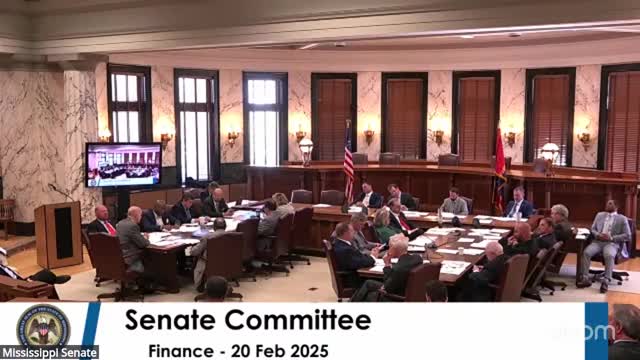Senator Brian proposes new tax strategy for sustainable highway funding
February 20, 2025 | Finance, Senate, Committees, Legislative, Mississippi
This article was created by AI summarizing key points discussed. AI makes mistakes, so for full details and context, please refer to the video of the full meeting. Please report any errors so we can fix them. Report an error »

The Mississippi Legislature convened on February 20, 2025, in Room 216 to address pressing financial issues, particularly concerning infrastructure funding. The meeting focused on the need for a sustainable revenue stream for road construction at all levels—state, city, and county.
Senator Brian initiated the discussion by highlighting the inadequacy of relying solely on gasoline taxes for road funding. He pointed out that as the number of gasoline vehicles declines and fuel efficiency increases, the revenue generated from fuel taxes will continue to diminish. To address this challenge, Senator Brian proposed diverting a percentage of sales, use, and income taxes to ensure that road funding keeps pace with inflation and economic growth.
Senator Sparks raised questions regarding the historical context of highway funding, specifically referencing the 1987 highway plan. He inquired whether indexing the fuel tax to inflation had been considered at that time, noting that inflation during the late 1970s and early 1980s was significant. Senator Sparks expressed concern about the sustainability of the current fuel tax model, emphasizing that it does not adequately support infrastructure needs.
The discussion also touched on the political motivations behind past highway funding decisions, with Senator Sparks recalling efforts to expand Highway 25. He criticized the removal of a sales tax on gasoline in favor of a per-gallon tax, which he deemed a mistake that has contributed to the current funding shortfall.
As the conversation progressed, the senators acknowledged the necessity of including electric vehicles in the funding equation, as they also contribute to road wear despite not using gasoline. Senator Sparks advocated for a user fee system that would equitably distribute road maintenance costs among all vehicle users, including those who drive heavier vehicles that cause more wear and tear on the roads.
The meeting concluded with a consensus on the need for innovative funding solutions to support Mississippi's infrastructure, recognizing that traditional methods may no longer suffice in the face of changing transportation trends. Further discussions and potential legislative actions are anticipated as the legislature seeks to address these critical funding challenges.
Senator Brian initiated the discussion by highlighting the inadequacy of relying solely on gasoline taxes for road funding. He pointed out that as the number of gasoline vehicles declines and fuel efficiency increases, the revenue generated from fuel taxes will continue to diminish. To address this challenge, Senator Brian proposed diverting a percentage of sales, use, and income taxes to ensure that road funding keeps pace with inflation and economic growth.
Senator Sparks raised questions regarding the historical context of highway funding, specifically referencing the 1987 highway plan. He inquired whether indexing the fuel tax to inflation had been considered at that time, noting that inflation during the late 1970s and early 1980s was significant. Senator Sparks expressed concern about the sustainability of the current fuel tax model, emphasizing that it does not adequately support infrastructure needs.
The discussion also touched on the political motivations behind past highway funding decisions, with Senator Sparks recalling efforts to expand Highway 25. He criticized the removal of a sales tax on gasoline in favor of a per-gallon tax, which he deemed a mistake that has contributed to the current funding shortfall.
As the conversation progressed, the senators acknowledged the necessity of including electric vehicles in the funding equation, as they also contribute to road wear despite not using gasoline. Senator Sparks advocated for a user fee system that would equitably distribute road maintenance costs among all vehicle users, including those who drive heavier vehicles that cause more wear and tear on the roads.
The meeting concluded with a consensus on the need for innovative funding solutions to support Mississippi's infrastructure, recognizing that traditional methods may no longer suffice in the face of changing transportation trends. Further discussions and potential legislative actions are anticipated as the legislature seeks to address these critical funding challenges.
View full meeting
This article is based on a recent meeting—watch the full video and explore the complete transcript for deeper insights into the discussion.
View full meeting
